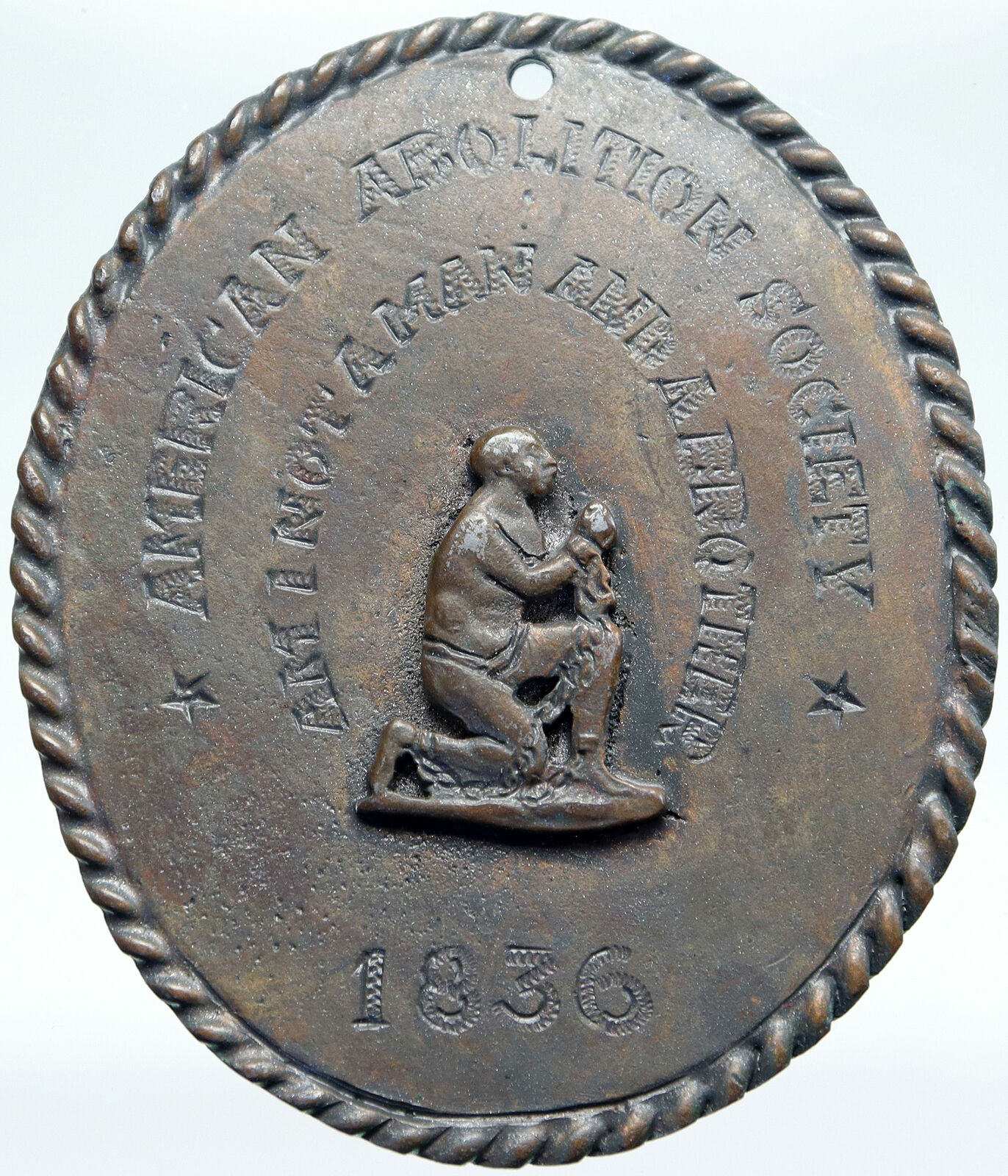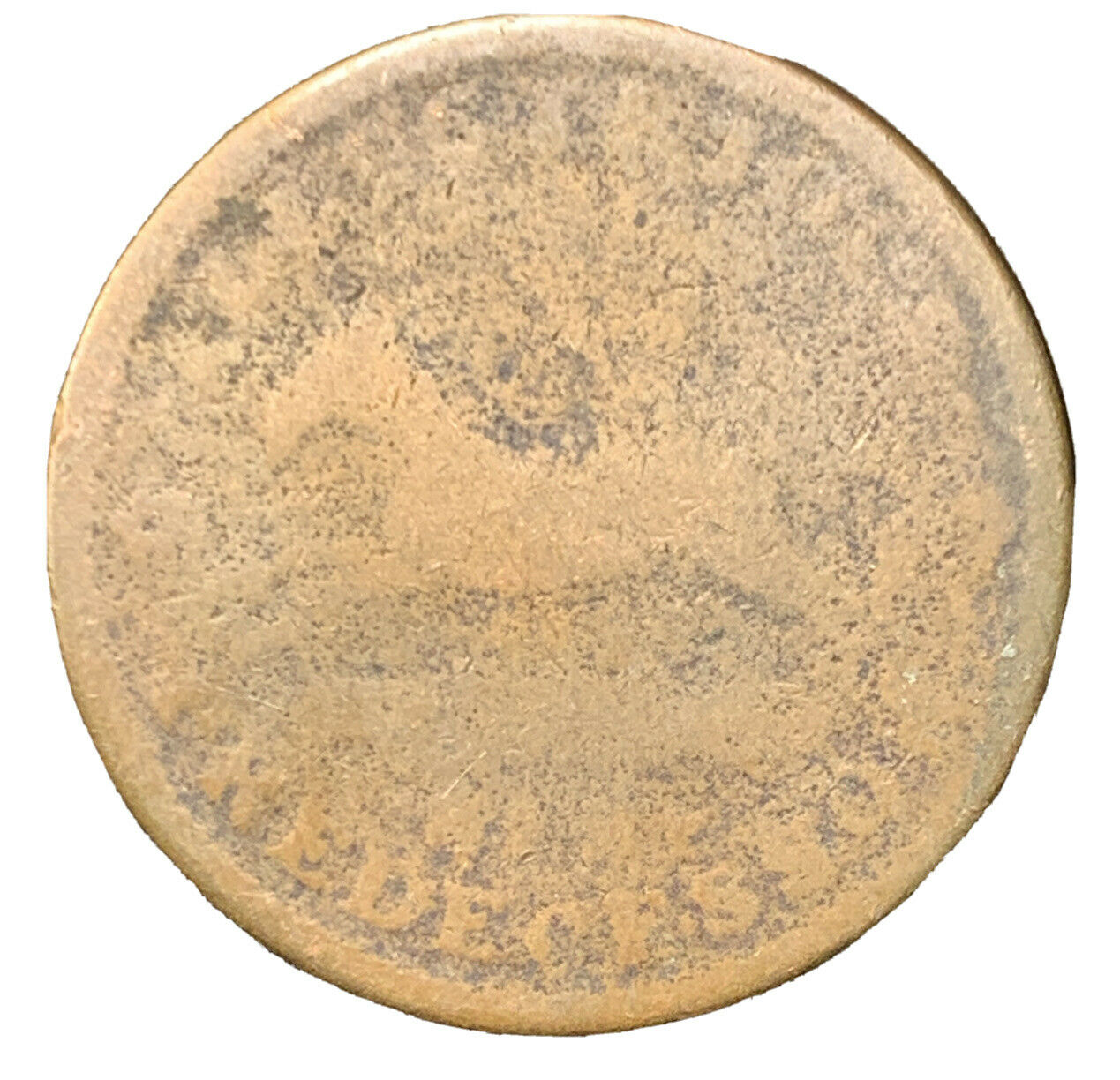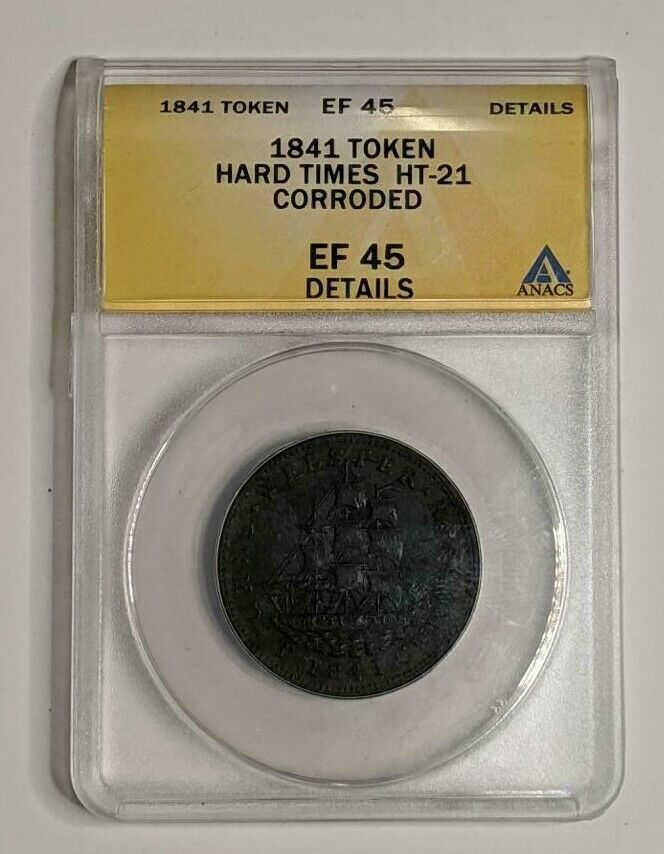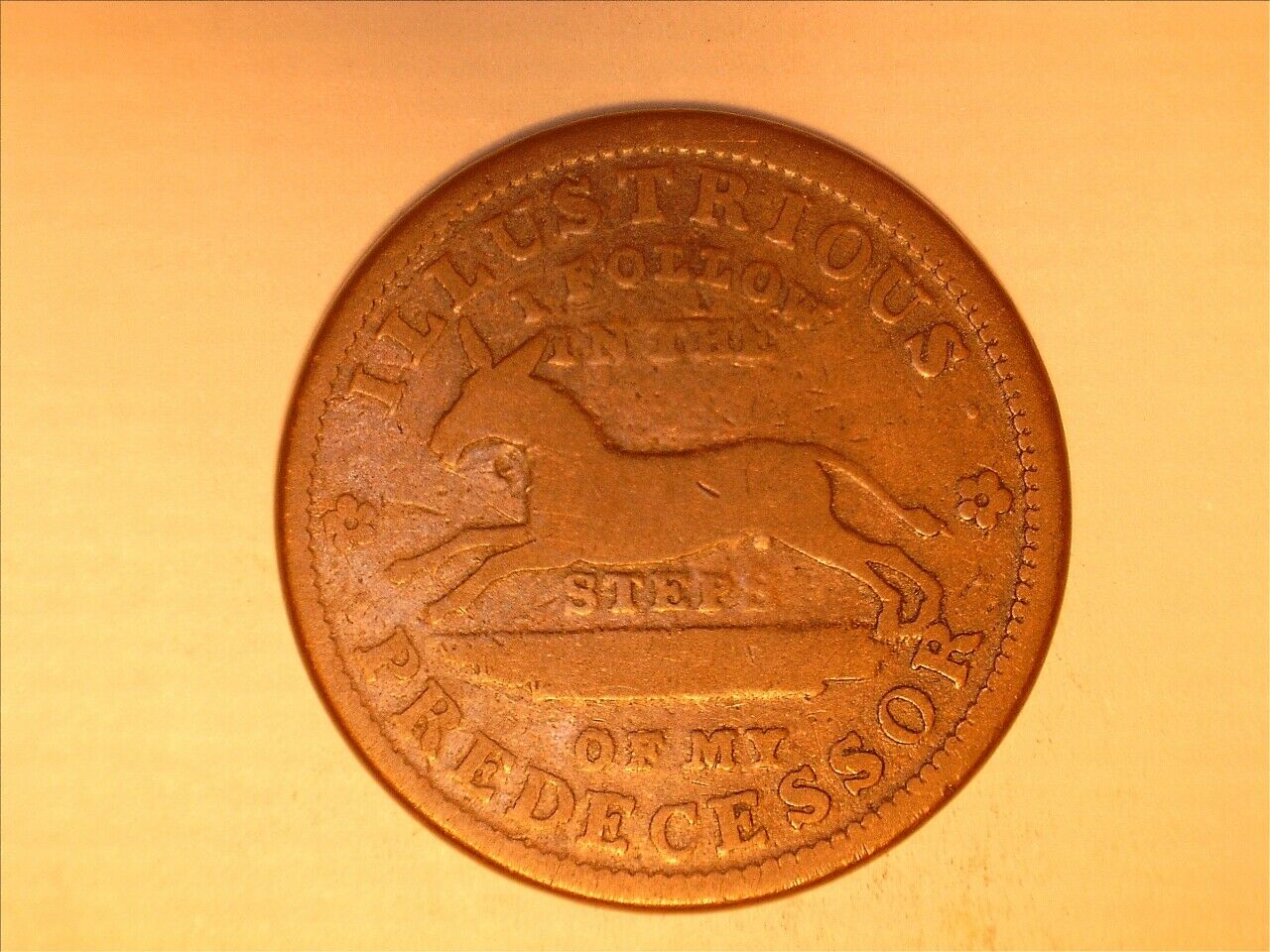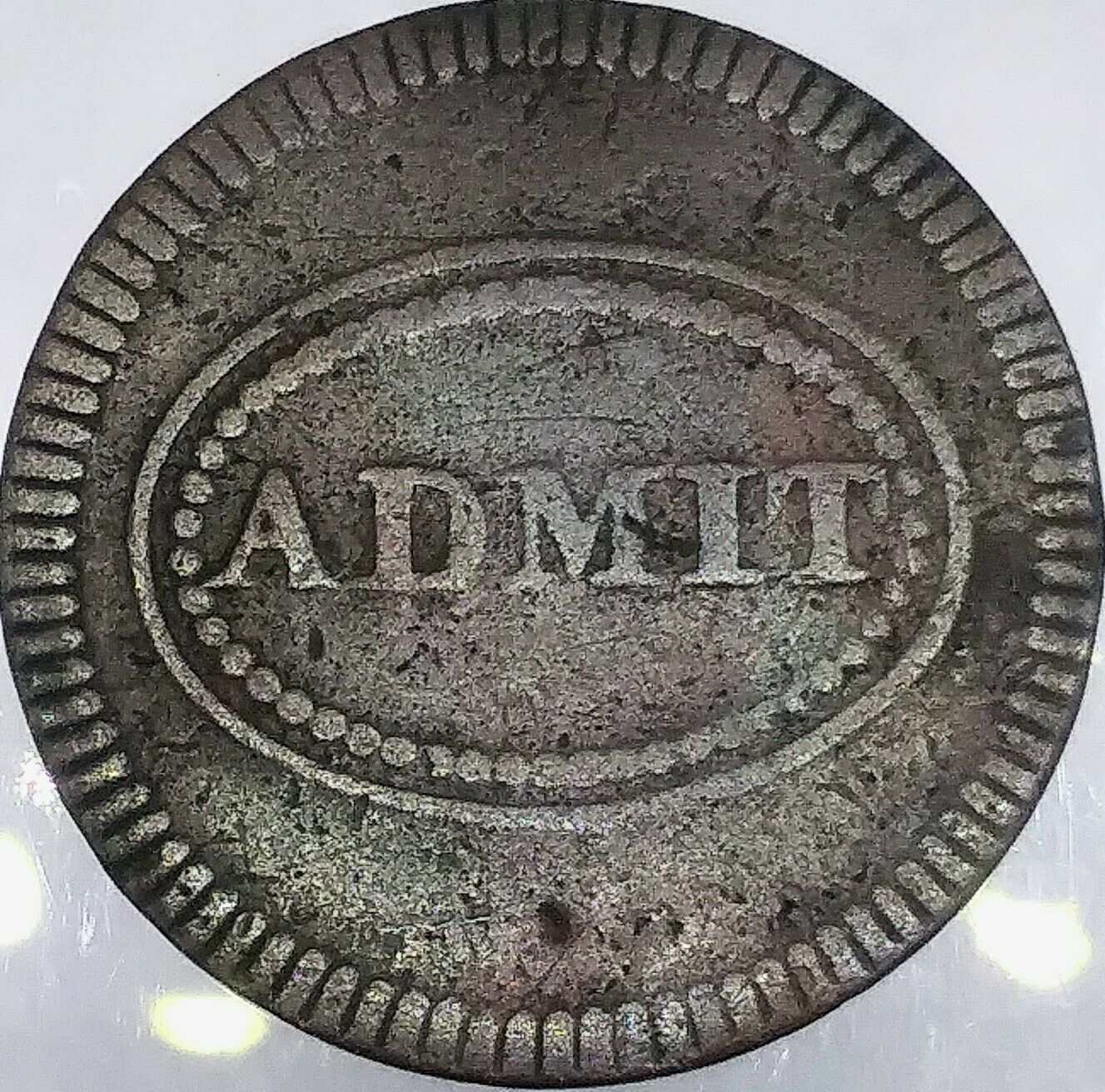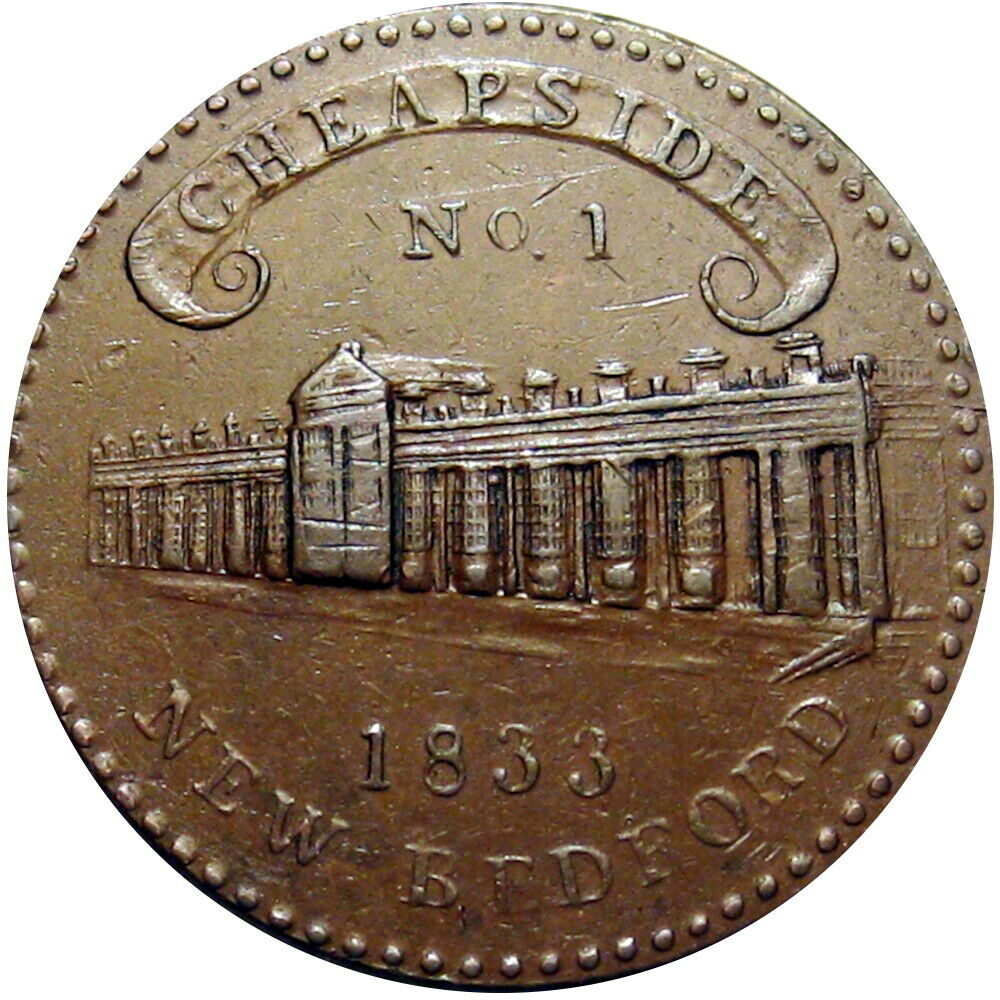-40%
1836 US Pre- CIVIL WAR Hard Times NYC ANTI SLAVERY ABOLITIONIST SOC Medal i87325
$ 11879.28
- Description
- Size Guide
Description
Item:i87325
Authentic Medal of:
United States of America - American Abolition Society
ABOLITIONIST ANTI-SLAVERY
1836 Bronze Medal 64mm x 53mm (56.09 grams)
* AMERICAN ABOLITION SOCIETY * AM I NOT A MAN AM I A BROTHER 1836, Chained Man kneeling.
WHAT SO EVER YE WOULD THAT MAN SHOULD DO TO YOU DO YE EVER SO TO THEM, Inscription in six lines.
You are bidding on the exact item pictured, provided with a Certificate of Authenticity and Lifetime Guarantee of Authenticity.
The
American Anti-Slavery Society
(
AASS
; 1833–1870) was an abolitionist society founded by William Lloyd Garrison and Arthur Tappan. Frederick Douglass, an escaped slave, was a key leader of this society who often spoke at its meetings. William Wells Brown was also a freed slave who often spoke at meetings. By 1838, the society had 1,350 local chapters with around 250,000 members.
Noted members included Susan B. Anthony, Elizabeth Cady Stanton, Theodore Dwight Weld, Lewis Tappan, James G. Birney, Lydia Maria Child, Maria Weston Chapman, Augustine Clarke, Samuel Cornish, George T. Downing James Forten, Abby Kelley Foster, Stephen Symonds Foster, Henry Highland Garnet, Beriah Green, who presided over its organizational meeting, Lucretia Mott, Wendell Phillips, Robert Purvis, Charles Lenox Remond, Sarah Parker Remond, Lucy Stone, and John Greenleaf Whittier, among others. Headquartered in New York City, from 1840 to 1870 the society published a weekly newspaper, the
National Anti-Slavery Standard.
By the 1820s, the controversy surrounding the Missouri Compromise had quieted down considerably, but was revived by a series of events near the end of the decade. Serious debates over abolition took place in the Virginia legislature in 1829 and 1831. (See Thomas Roderick Dew#Dew and slavery.) In the North, discussion began about the possibility of freeing the slaves and then resettling them back in Africa (a proposal that led to the founding of Liberia). Agitation increased with the publication of David Walker's
Appeal to the Colored Citizens of the World
in 1829, Nat Turner's slave rebellion in 1831, and Andrew Jackson's handling of the nullification crisis that same year. According to Louis Ruchame, "The Turner rebellion was only one of about 200 slave uprisings between 1776 and 1860, but it was one of the bloodiest, and thus struck fear in the hearts of many white southerners. Nat Turner and more than 70 enslaved and free blacks spontaneously launched a rebellion in Southampton County, Virginia, in August 1831. They moved from farm to farm, indiscriminately killing whites along the way and picking up additional slaves. By the time the militia put down the insurrection, more than 80 slaves had joined the rebellion, and 60 whites lay dead. While the uprising led some Southerners to consider abolition, the reaction in all Southern states was to tighten the laws governing slave behavior."
That same year, South Carolina's opposition to the federal tariff led the legislature to declare that the law was null and void in the state, and the state's leaders spoke of using the militia to prevent federal customs agents from collecting the tax. President Andrew Jackson swept aside the states' rights arguments and threatened to use the army to enforce federal laws. In the face of Jackson's determination, the state backed down, but the episode raised fears throughout the South that it was only a matter of time before Congress would begin to tamper with slavery. Southern anxiety increased in 1833 with the founding of the American Anti-Slavery Society in Philadelphia.
In the 1820s the focus of anti-slavery was the American Colonization Society, founded on Madisonian principles of gradual, government-compensated emancipation. Consistent with existing and durable prejudices in the nation at the time, President James Madison believed that blacks and whites could not integrate into society together, and thus wanted to institute a policy of separation. Madison said that integration (at the time called "amalgamation") was impossible, because there would always be oppression, hatred, and hostility between former slaves and former slave holders. He also claimed, in his so-called "Memorandum on an African Colony for Freed Slaves", that “freedmen retained the vices and habits of slaves.” He advocated for resettlement of former slaves to the west coast of Africa, where the Society was to found Liberia.
At this point, the American Anti-Slavery Society formed to appeal to the moral and practical circumstances that, at this point, propped up a pro-slavery society.
William Lloyd Garrison
was the original founder of the American Anti-Slavery Society in 1833. Three years before founding the Society, Garrison began the newspaper
The Liberator.
This abolitionist paper argued for the immediate freedom of all slaves and operated under the motto of "Our country is the world - our countrymen are mankind."
Frederick Douglass
was a notable and frequent speaker at Society meetings. Douglass was born a slave and, upon his freedom, developed written and verbal communicative skills that would thrust him to the forefront of the abolitionist movement
Francis Jackson, grandfather of John Brown's raider Francis Jackson Meriam, was a president of the Society.
The Society
The society was considered controversial and was sometimes met with violence. According to the
Encyclopedia Britannica
, "The society's antislavery activities frequently met with violent public opposition, with mobs invading meetings, attacking speakers, and burning presses." In the mid-1830s, slavery had become so economically involved in the U.S. that getting rid of it would cause a major blow to the economy.
A convention of abolitionists was called for December 1833 at the Adelphi Building in Philadelphia. The convention had 62 delegates, of which 21 were Quakers. The new American Anti-Slavery Society charged William Lloyd Garrison with writing the organization's new declaration. The document condemns the institution of slavery and accuses slave owners of the sin of being a "man-stealer". It calls for the immediate abolition of slavery without conditions, and is critical of the efforts of the American Colonization Society. At the same time, it declares the group to be pacifist, and the signers agree, if necessary, to die as martyrs. Beginning in January 1834 and ending in August of the same year, the society published the American Anti-Slavery Reporter, a monthly periodical containing professional essays regarding the subject of slavery. In July 1834 the aims of the society appear to have been misrepresented in the prelude to the Farren Riots in New York, which led to attacks on the homes and properties of abolitionists. After the riots were quelled the society issued a public disclaimer:
The undersigned, in behalf of the Executive Committee of the ‘American Anti-Slavery Society’ and of other leading friends of the cause, now absent from the city, beg the attention of their fellow-citizens to the following disclaimer:— 1. We entirely disclaim any desire to promote or encourage intermarriages between white and coloured persons. 2. We disclaim and entirely disapprove the language of a handbill recently circulated in this city, the tendency of which is thought to be to excite resistance to the laws. Our principle is, that even hard laws are to be submitted to by all men, until they can by peaceable means be altered. We disclaim, as we have already done, any intention to dissolve the Union, or to violate the constitution and laws of the country, or to ask of Congress any act transcending their constitutional powers, which the abolition of slavery by Congress in any state would plainly do. July 12, 1834. ARTHUR TAPPAN. JOHN RANKIN
The black clergyman Theodore S. Wright was a significant founding member and served on the executive committee until 1840. A Presbyterian minister, Wright, together with well-known spokesmen such as Tappan and Garrison, agitated for temperance, education, black suffrage, and land reform. According to Wright,
I will say nothing about the inconvenience which I have experienced myself, and which every man of color experiences, though made in the image of God. I will say nothing about the inconvenience of traveling; how we are frowned upon and despised. No matter how we may demean ourselves, we find embarrassments everywhere. But, this prejudice goes farther. It debars men from heaven. While sir, slavery cuts off the colored portion of the community from religious privileges men are made infidels. What, they demand, is your Christianity? How do you regard your brethren? How do you treat them at the Lord's table? Where is your consistency in talking about the heathen, traversing the ocean to circulate the Bible everywhere, while you frown upon them at the door? These things meet us and weigh down our spirits....
Many founding members used a practical approach to slavery, saying economically it did not make sense. Wright used the rhetoric of religion to elicit empathy toward African Americans, and presented slavery as a moral sin.
Frederick Douglass had seen the frustration that Garrison felt towards those who disagreed with him, but wrote many letters to Garrison describing to him the details of the prejudices that slavery had caused. One in particular was directed towards the church. According to Douglass,
In the South I was a member of the Methodist Church. When I came north, I thought one Sunday I would attend communion, at one of the churches of my denomination, in the town I was staying. The white people gathered round the altar, the blacks clustered by the door. After the good minister had served out the bread and wine to one portion of those near him, he said, "These may withdraw, and others come forward"; thus he proceeded till all the white members had been served. Then he drew a long breath, and looking out towards the door, exclaimed, "Come up, colored friends, come up! for you know God is no respecter of persons!" I haven't been there to see the sacraments taken since.
Douglass hoped his letters would remind Garrison why slavery should be abolished. Douglass' reminder did not ease the minds of those against Garrison.
In 1840, the American Anti-Slavery Society was invited to the World Anti-Slavery Convention in London, England, to meet and network with other abolitionist initiatives of the time. Additionally, it served to strengthen each group's commitment to racial equality. At this convention, female delegates were not allowed to participate in the event, but rather observe only, from a gallery. The ruling to exclude female abolitionists caused feminists Lucretia Mott and Elizabeth Cady Stanton to form a group for women’s rights, though it garnered little success initially. Garrison arrived to the convention late and upon hearing of the decision not to allow women to participate, he chose not to enter the Convention, but viewed the proceedings with the women in the gallery. This became the genesis for the women’s suffrage movement.
Hard-times tokens
are American large or half cent-sized copper tokens, struck from about 1833 through 1843, serving as unofficial currency. These privately made pieces, comprising merchant, political and satirical pieces, were used during a time of political and financial crisis in the United States.
In 1832, President Andrew Jackson ran for re-election and called for the abolition of the Second Bank of the United States. While he won the election, he worked to weaken the bank before the charter expired in 1836. Without the Bank of the United States, state banks attempted to fill the paper money gap and issued a large number of bank notes, which fueled inflation. Hoping to halt the inflation and speculation in public lands, Jackson and his Treasury secretary, Levi Woodbury, issued the Specie Circular on July 11, 1836. The circular simply stated that as of August 15 1836, banks and others who received public money were required to accept only gold and silver coins in payment for public lands.
Instead of the intended results, the circular spelled the end of a time of economic prosperity. The circular set into motion a panic, and the public began hoarding specie. Without specie to pay out, banks and merchants began having financial troubles. It wasn't too long before the effects of Jackson's decision were felt across the nation as banks and businesses failed, and a depression ensued.
By this time, Jackson's vice president, Martin Van Buren, was the elected president in office. The period of economic hardship, the Panic of 1837, during Van Buren's presidency came to be known as the "Hard Times".
The
Panic of 1837
was a financial crisis in the United States that touched off a major recession that lasted until the mid-1840s. Profits, prices, and wages went down while unemployment went up. Pessimism abounded during the time. The panic had both domestic and foreign origins. Speculative lending practices in western states, a sharp decline in cotton prices, a collapsing land bubble, international specie flows, and restrictive lending policies in Great Britain were all to blame. On May 10, 1837, banks in New York City suspended specie payments, meaning that they would no longer redeem commercial paper in specie at full face value. Despite a brief recovery in 1838, the recession persisted for approximately seven years. Banks collapsed, businesses failed, prices declined, and thousands of workers lost their jobs. Unemployment may have been as high as 25% in some locales. The years 1837 to 1844 were, generally speaking, years of deflation in wages and prices.
Abolitionism in the United States
was the movement before and during the American Civil War to end slavery in the United States. In the Americas and western Europe, abolitionism was a movement to end the Atlantic slave trade and set slaves free. In the 17th century, enlightenment thinkers condemned slavery on humanistic grounds and English Quakers and some Evangelical denominations condemned slavery as un-Christian. At that time, most slaves were Africans, but thousands of Native Americans were also enslaved. In the 18th century, as many as six million Africans were transported to the Americas as slaves, at least a third of them on British ships to North America. The colony of Georgia originally abolished slavery within its territory, and thereafter, abolition was part of the message of the First Great Awakening of the 1730s and 1740s in the Thirteen Colonies.
Rationalist thinkers of the Age of Enlightenment criticized slavery for violating natural rights. A member of the British Parliament, James Edward Oglethorpe, was among the first to articulate the Enlightenment case against slavery. Founder of the Province of Georgia, Oglethorpe banned slavery on humanistic grounds. He argued against it in Parliament and eventually encouraged his friends Granville Sharp and Hannah More to vigorously pursue the cause. Soon after his death in 1785, Sharp and More joined with William Wilberforce and others in forming the Clapham Sect. Although anti-slavery sentiments were widespread by the late 18th century, many colonies, churches and emerging nations (notably in the southern United States) continued to use and defend the traditions of slavery.
During and immediately following the American Revolution, Northern states, beginning with Pennsylvania in 1780, passed legislation during the next two decades abolishing slavery, sometimes by gradual emancipation. Massachusetts ratified a constitution that declared all men equal; freedom suits challenging slavery based on this principle brought an end to slavery in the state. In other states, such as Virginia, similar declarations of rights were interpreted by the courts as not applicable to Africans. During the ensuing decades, the abolitionist movement grew in Northern states, and Congress regulated the expansion of slavery as new states were admitted to the Union. Britain banned the importation of African slaves in its colonies in 1807 and abolished slavery in the British Empire in 1833. The United States criminalized the international slave trade in 1808 and made slavery unconstitutional in 1865 as a result of the American Civil War.
Historian James M. McPherson defines an abolitionist "as one who before the Civil War had agitated for the immediate, unconditional and total abolition of slavery in the United States". He does not include antislavery activists such as Abraham Lincoln, U.S. President during the Civil War, or the Republican Party, which called for the gradual ending of slavery.
Abolitionism in the United States was an expression of moralism, operating in tandem with other social reform efforts, such as the temperance movement.
Frequently Asked Questions
Mr. Ilya Zlobin
, world-renowned expert numismatist, enthusiast, author and dealer in authentic ancient Greek, ancient Roman, ancient Byzantine, world coins & more.
Who am I dealing with?
You are dealing with Ilya Zlobin, ancient coin expert, enthusiast, author and dealer with an online store having a selection of over 15,000 items with great positive feedback from verified buyers and over 10 years experience dealing with over 57,000 ancient and world coins and artifacts. Ilya Zlobin is an independent individual who has a passion for coin collecting, research and understanding the importance of the historical context and significance all coins and objects represent. Most others are only concerned with selling you, Ilya Zlobin is most interested in educating you on the subject, and providing the largest selection, most professional presentation and service for the best long-term value for collectors worldwide creating returning patrons sharing in the passion of ancient and world coin collecting for a lifetime.
How long until my order is shipped?
Orders are shipped by the next business day (after receipt of payment) most of the time.
How will I know when the order was shipped?
After your order has shipped, you will be left positive feedback, and that date could be used as a basis of estimating an arrival date. Any tracking number would be found under your 'Purchase history' tab.
USPS First Class mail takes about 3-5 business days to arrive in the U.S. International shipping times cannot be estimated as they vary from country to country.
Standard international mail to many countries
does not
include a tracking number, and can also be slow sometimes.
For a tracking number and signature confirmation, you may want to do Express Mail International Shipping, which costs more, however, is the fastest and most secure. Additionally you may be able to receive your order in as little as 3-5 business days using this method. For Express Mail International, it may be possible to place up to 10-15 items in one package (for the one shipping cost) as it is flat rate envelope, which may be the most cost-effective, secure and fastest way to receive items internationally. Send me a message about this and I can update your invoice should you want this method.
Getting your order to you, quickly and securely is a top priority and is taken seriously here.
Great care is taken in packaging and mailing every item securely and quickly.
Please be aware, I cannot take responsibility for any postal service delivery delays, especially for international packages as it may happen in rare instances.
What is a certificate of authenticity and what guarantees do you give that the item is authentic?
Each of the items sold here, is provided with a Certificate of Authenticity, and a Lifetime Guarantee of Authenticity, issued by a world-renowned numismatic and antique expert that has identified over 57,000 ancient coins and has provided them with the same guarantee. You will be very happy with what you get with the COA; a professional presentation of the coin, with all of the relevant information and a picture of the coin you saw in the listing. Additionally, the coin is inside it's own protective coin flip (holder), with a 2x2 inch description of the coin matching the individual number on the COA.
On the free-market such a presentation alone, can be considered a - value all in itself, and it comes standard with your purchases from me,
FREE.
With every purchase, you are leveraging my many years of experience to get a more complete context and understanding of the piece of history you are getting. Whether your goal is to collect or give the item as a gift, coins presented like this could be more prized and valued higher than items that were not given such care and attention to.
Buy a coin today and own a piece of history, guaranteed.
Is there a money back guarantee?
I offer a 30 day unconditional money back guarantee. I stand behind my coins and would be willing to exchange your order for either store credit towards other coins, or refund, minus shipping expenses, within 30 days from the receipt of your order. My goal is to have the returning customers for a lifetime, and I am so sure in my coins, their authenticity, numismatic value and beauty, I can offer such a guarantee.
When should I leave feedback?
Once you receive your order, please leave a positive feedback. Please don't leave any negative feedbacks, as it happens sometimes that people rush to leave feedback before letting sufficient time for their order to arrive. Also, if you sent an email, make sure to check for my reply in your messages before claiming that you didn't receive a response. The matter of fact is that any issues can be resolved, as reputation is most important to me. My goal is to provide superior products and quality of service.
How and where do I learn more about collecting ancient coins?
Visit the "
Guide on How to Use My Store
" for on an overview about using my store, with additional information and links to all other parts of my store which may include educational information on topics you are looking for.
